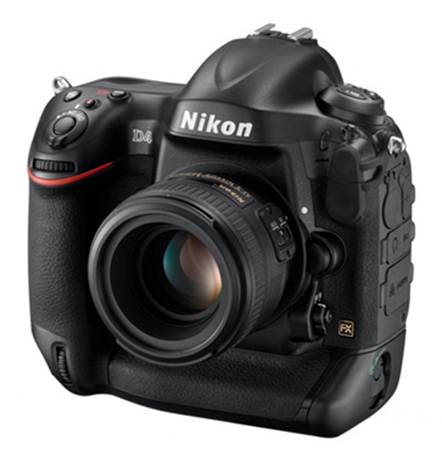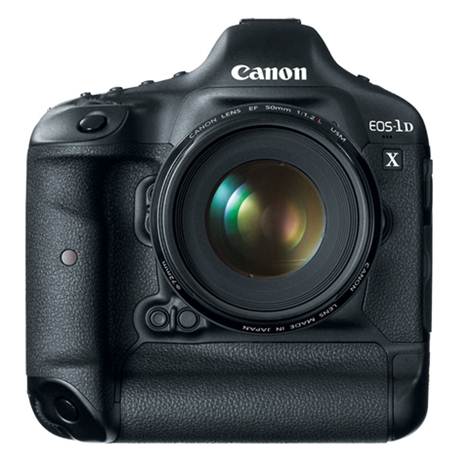Professional cameras' overall performance
is the one factor that distinguishes them from other levels of DSLRs. From
design to features and performance, professional cameras have their way of
asserting their superiority. Today photographers are serious about each picture
they capture and they want a camera to match their high expectations. This is
where full frame cameras come in. They are meant for professionals and serious
enthusiasts who are willing to pay a fortune for the added advantage in
performance.

Nikon
D4 and Canon EOS-1DX
In full frame cameras, the frames are much
wider and the resolution is simply brilliant. This is because there is no crop
factor on the sensor. This year we added another category to the professional
DSLR known as advanced professional DSLR. For this category, the price
parameter was set between 3-5 Lakhs. We had camera manufactures Nikon and Canon
send in their respective cameras for the shootout. The contenders for the advanced
professional DSLR shootout are Nikon D4 and Canon EOS-1 D X. We put them to
test to see which has an edge over the other.
Nikon D4
Price: $5,999
Nikon D4 is a relatively new entrant in
Nikon's professional camera systems. Compared to the Nikon D3S it offers a
better resolution, faster burst mode shooting and better ISO and movie
recording performance. Just one look at the D4 and you will know that this
beast is meant to deliver an impactful performance.

The D4 has a newly developed FX-format CMOS
sensor with I 6.2 effective megapixels. The camera is the first to house the
XQD card slot which is meant to perform at higher speeds than CF or any other
card format. The build and design of the D4 is robust and advanced. The buttons
and functions on the D4 are well laid out, making it comfortable to shoot with.
The body is designed to give a firm hand grip.
Performance
The Nikon D4 is a performer, no doubt, but
we wanted to see how it performed against Canon's 1DX. While we were shooting
with the D4 we could feel the steady image performance. The depth and detail in
each image were stunning. The camera performed well, except one glitch, the
camera was not able to lock focus on the subject, especially in dark areas.
Apart from that, the D4's quick and accurate 5 I point autofocus system was
spot on and sharp, even when capturing moving subjects. The camera was tested
on its burst rate, which sported a 10fps. While shooting with the D4 on burst
mode, the shutter fired rapidly and even though we could spot a few out of
focus frames, the D4 performed really well overall.
The biggest advantage on the D4 is its
ability to provide the user with user friendly functions. The white balance is
accurate and the colours on the D4 are balanced and vivid. The detail on
shadows and highlights were sorted, but we had to make sure to meter to expose
our subject one or two step below.
Specifications
·
Lens mount: Nikon F bayonet mount
·
Effective pixels: 16.2 million
·
Sensor size: 36.0mm x 23.9mm
·
Mage sensor format: FX
·
Mage sensor type: CMOS
·
Total Pixels: 16.6 million
·
File Format Still Images: JPEG: JPEG-Baseline
Compliant; can be selected from Size Priority and Optimal Quality JPEG:
JPEG-Baseline Compliant with fine (approx 1:4), Normal (approx 1:8) or Basic
(approx 1:16) Compression NEF (RAW) + JPEG: Single Photograph Recorded in both
NEF (RAW) and JPEG Formats TIFF (RGB)
·
Viewfinder: Eye-level Pentaprism Single-Lens
Reflex Viewfinder
·
Viewfinder frame coverage: FX (36x24): 100%
horizontal and 100% vertical approx. 1.2x (30x20): 97% horizontal and 97%
vertical approx. DX (24x16): 97% horizontal and 97% vertical approx. 5:4
(30x24): 97% horizontal and 100% vertical approx.
·
Single-point AF Mode: Yes
·
Dynamic AF Mode: Number of AF points: 9,21,51
and 51 (3D-tracking)
Canon EOS-1DX
Price: $6,799

Canon
EOS-1DX
Canon EOS-1 D X is a top professional DSLR
in the EOS system. The 1DX does it all for you; resolution, speed and design.
The robust look on the 1DX speaks a lot about the camera. There are quite a few
buttons aligned in a uniform manner, and some of them do two or more functions.
This can get a bit confusing at times, but it's only a matter of getting used
to it. The camera body has two separate CF slots for image and video storage
separately.
In terms of user friendly features, we felt
the 1DX lacked a bit. We were not impressed with the design as compared to the
D4.
Performance
Canon EOS 1DX features an 18.1 megapixel
full frame CMOS sensor, which delivers brilliant resolution. Also, the metering
was spot on, but at certain situations you need to learn how to use it to
produce intelligent photographs. The autofocus on the 1DX is fast, accurate and
tracks moving subjects well.
If you are a person who works on sports or
similar subjects, you will need the speed of the 1DX. The 1DX's 12 fps is good.
We had fun shooting with its continuous burst mode. With the addition of a
better AF-tracking system, the 1DX is far superior to the D4. It can track
subjects at near and far off distances without error.
Specifications
·
Recording media: Type 1 or IICF card, UDMA mode
7-compatible Dual CF card slots
·
Compatible lenses: Canon EF lenses (except EF-S
lenses) (35mm-equivalent lens focal length will be as indicated on tbe lens)
·
Lens mount: Canon EF mount
·
Mage sensor: 18.10
megapixels Approx. 36 x 24mm CMOS sensor
·
Viewfinder: Eye-level pentaprism witb vertical /
horizontal approx. 100% (with eye point approx. 20mm) coverage
·
Mage type: JPEG. RAW (14-bit Canon original),
RAW+JPEG simultaneous recording enabled
·
Shutter speeds: 1/8000sec. to 30secs„ bulb
(Total shutter speed range. Available range varies by shooting mode.), X-sync
at 1/250 sec.
·
LCD monitor: Wide, 3.2-in. (3:2) with approx.
1.04 million dots TFT color, liquid-crystal monitor
·
In-camera RAW image processing: Brightness
correction, White balance, Picture Style,
·
Auto Lighting Optimise!. High ISO speed noise
reduction, JPEG image-recording quality, Colourspace, Peripheral illumination
correction, Distortion correction and Chromatic aberration correction
·
Dimensions (WxHxD): Approx. 158 x 163.6 x 82.7mm
/ 6.2 x 6.4 x 3.3in.
Conclusion
Nikon D4
We loved the camera for its performance in
colour and detail. The D4 has a more ergonomic design as compared to Canon's 1DX.
The D4 is a user friendly camera; simple details, like the back-illuminated
buttons help you set the camera settings accurately in low light conditions.
Apart from stills, the D4 can be impressive in recording videos too.
Canon EOS 1DX
The 1DX expands on the AF-Servo code to
work more specifically for moving subjects' type and condition, and the images
produced are high quality. The 1DX is, without a doubt, an amazing piece of
equipment. The focusing system and the 12 fps work perfectly for sports and
other high speed action shots. The Canon 1DX's images were much sharper and
filled with more detail and colour.